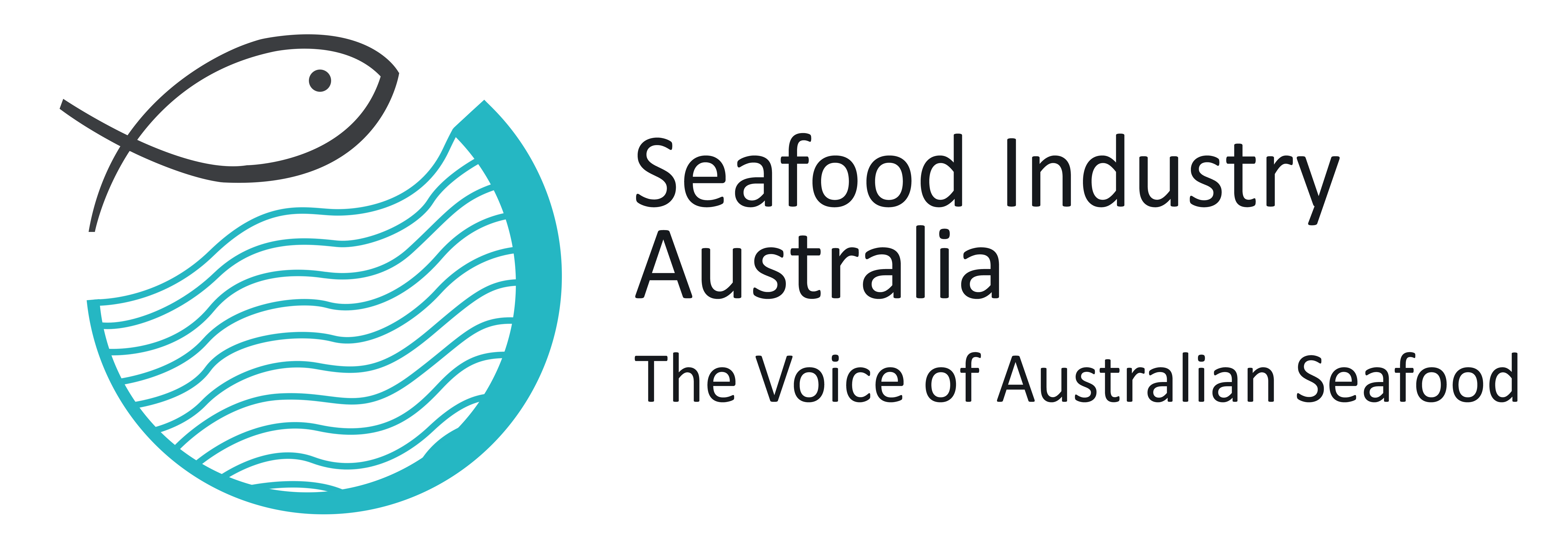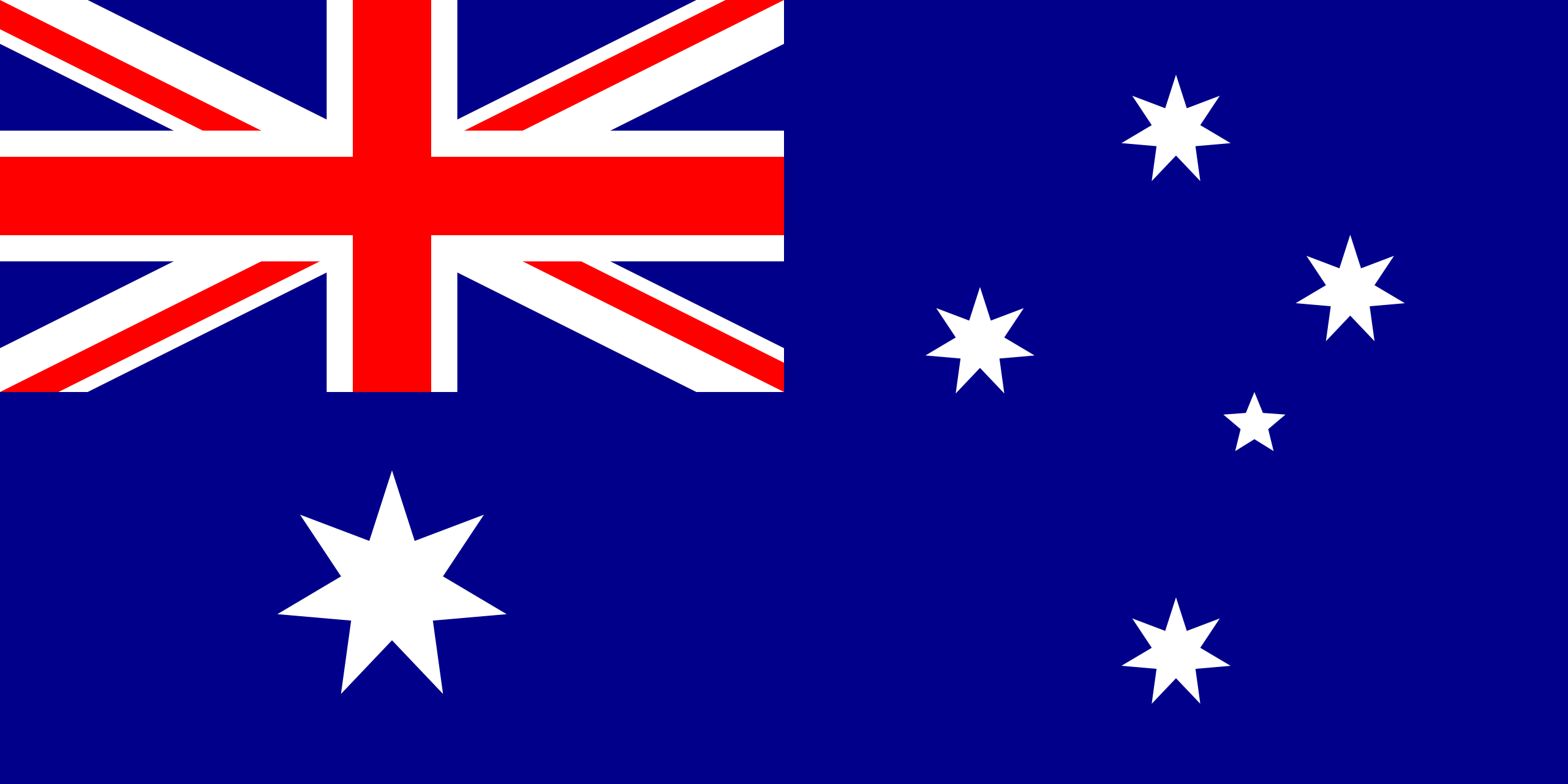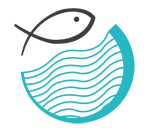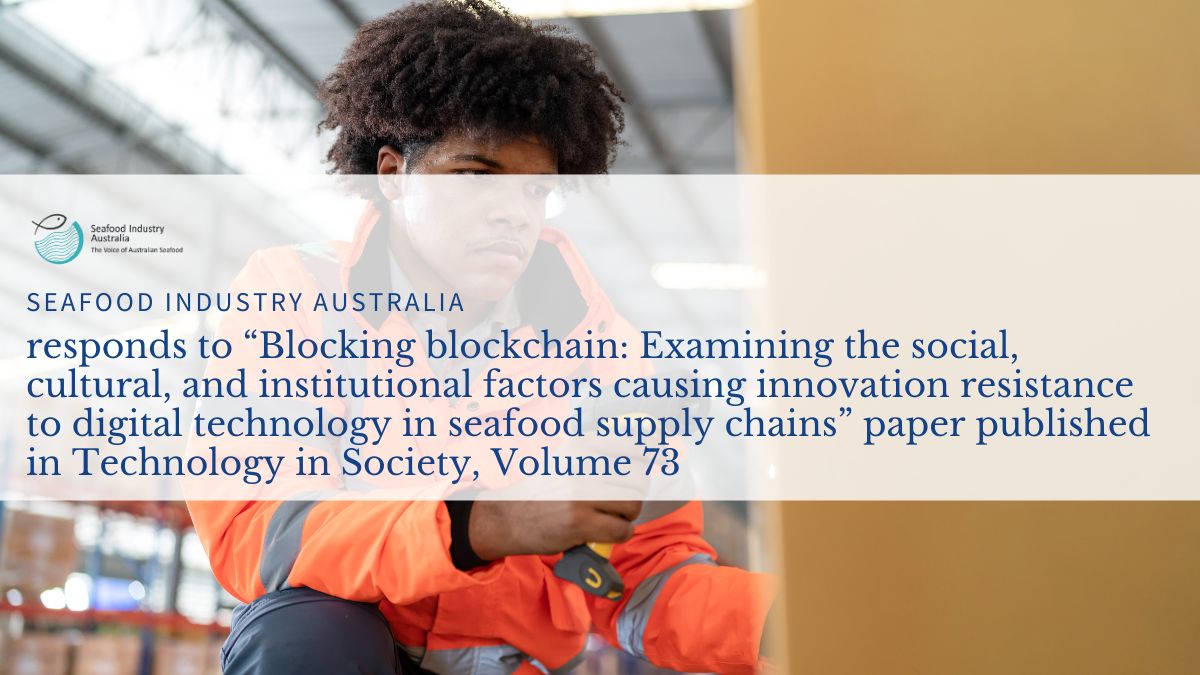
Seafood Industry Australia responds to “Blocking blockchain: Examining the social, cultural, and institutional factors causing innovation resistance to digital technology in seafood supply chains” paper published in Technology in Society, Volume 73
Seafood Industry Australia (SIA), the national peak-body representing the Australian seafood industry, has responded to the release of Benjamin S. Thompson and Sascha Rust’s “Blocking blockchain: Examining the social, cultural, and institutional factors causing innovation resistance to digital technology in seafood supply chains” paper published in Technology in Society (Volume 73, May 2023, 102235).
“First and foremost, the origin of seafood being sold or served in a retail or hospitality setting must always be available for all food safety purposes,” SIA CEO Veronica Papacosta said.
“The Australian seafood industry is deeply committed to discussions on how we can further our use of traceability and blockchain technology. There are a number of retailers, both in Victoria and New South Wales, holding third-party chain of custody certification meaning everything sold can be traced back to a particular boat, and its journey through the supply chain. In addition, SIA has a project underway with OpenSC and Laava looking at how we can develop and implement a unique identifier on seafood packaging to verify and authenticate the product’s origin using blockchain. This is currently focused on overseas markets, as this is actually where we see high-levels of counterfeit products being produced.
“The industry is actively involved in discussions on how we can continue to embrace technology and further develop supply chain transparency. Currently, the seafood industry upholds the industry standard. Consumers are able to identify a product’s species, confirm its origin in retail settings, and soon in a hospitality setting. Just like you can with any other protein source. This paper highlights the importance of purchasing your seafood through a registered and accredited seafood trader like the Melbourne Seafood Centre, Sydney Fish Market, the co-op network, or a trusted retailer.
“Australia’s commercial fishers adhere to extremely strict regulations and monitoring to ensure we maintain healthy stocks and act in accordance with the law. There are prescriptive management plans, quotas and licences in place controlling what can be caught, where, when and how.
“It is mandatory for Australia’s Commonwealth commercial fishers to be covered by mandatory Vessel Monitoring Systems (VMS) which is essentially a GPS locator that shows where all of Australia’s commercial fishing boats are in real-time to ensure boats remain in the areas they are permitted. In addition, the Australian seafood industry is covered by compulsory electronic monitoring (e-monitoring) which is a system of video cameras and sensors capable of monitoring and recording fishing activities, which can be reviewed later to verify what fishers report in fishing logbooks. Finally, all fish caught by Australia’s commercial fishers must be tracked and accounted for in their sales data.
“We don’t want to obscure what is really happening at sea, and we cannot. As an industry we value being transparent and accountable for our actions.
“Sadly, the researchers have lost an opportunity for what could have been a meaningful engagement with industry in favour of shock and awe.
“We’d like to see the methodology the researchers used, and know more about who was spoken to and where they sit in the industry to better understand the context of these claims.
“The broad-stroke statements made in this paper unjustly damage the livelihood, reputation and hard work of tens of thousands of hard working Australians, and have documented and broad reaching impacts on the mental health of our sector.
“The Australian seafood industry has a zero tolerance for any illegal activity. As an industry our priority is the ocean. It’s our future and the future of generations to come.”
<ENDS>
For more information or to organise an interview please contact
SIA Communications and Public Affairs manager Jessica McInerney
E: jessica@463.9af.myftpupload.com M: 0420 695 431
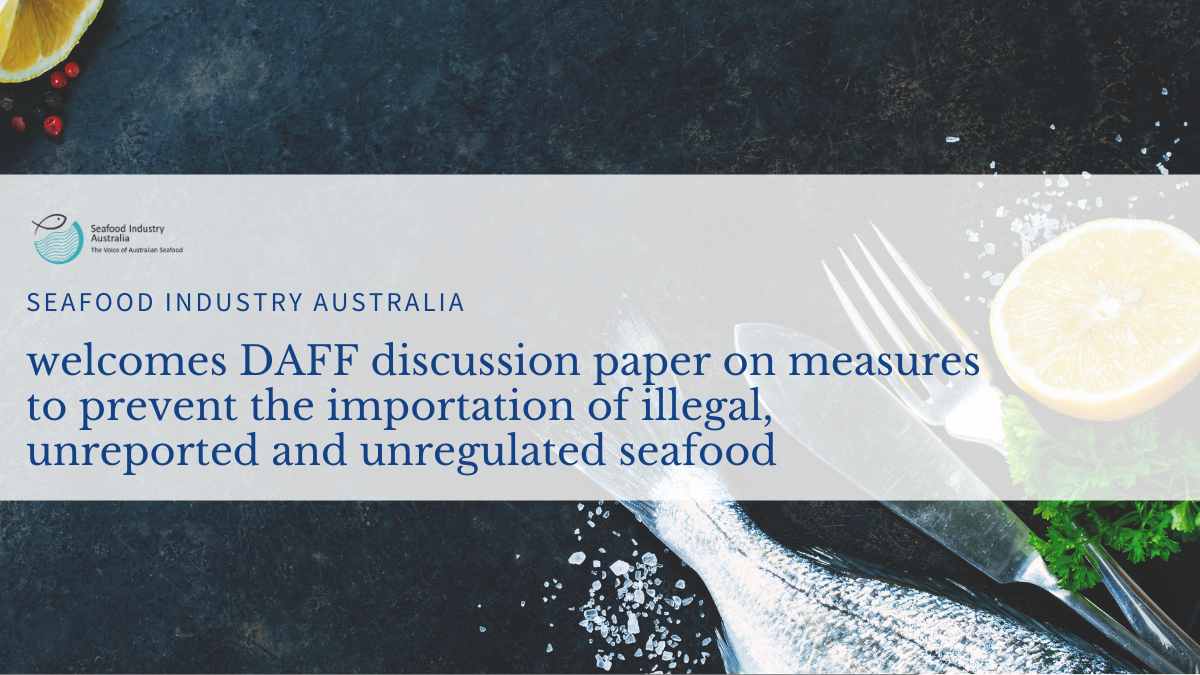
Seafood Industry Australia welcomes DAFF discussion paper on measures to prevent the importation of illegal, unreported and unregulated seafood
Seafood Industry Australia (SIA), the national peak-body representing the Australian seafood industry, has welcomed the Department of Agriculture, Fisheries and Forestry newly released discussion paper on measures to prevent the importation of illegal, unreported and unregulated seafood.
“The Australian seafood industry supports any efforts to curb illegal, unreported and unregulated (IUU) fishing globally,” SIA CEO Veronica Papacosta said.
“We acknowledge internationally there are some fisheries that are not as well managed as our own and we believe a framework to address the importation of seafood from fisheries that involve IUU fishing practices is important.”
“Australia utilises a comprehensive strategy to tackle IUU fishing. Robust domestic measures and, stringent legal and regulatory frameworks are implemented to discourage illegal fishing in Australian waters and prohibit the landing of illicitly caught fish in Australian ports. International collaboration remains crucial to effectively combat IUU fishing, and Australia is actively involved in bilateral, regional, and multilateral platforms focused on addressing the issue. Moreover, efforts are made to enhance the ability of neighbouring countries to combat IUU fishing in their respective waters and the high seas.”
“Australian, and other international fisheries like the US, NZ , Canada and the UK are at the forefront of sustainability, worker welfare and technological advancements and work hard to lead other nations in how to do better.”
“Australian seafood is one of the most sustainable, well-managed protein sources in the world and we welcome any measures to safeguard the future of global fish-stocks and protect our international industry workers.”
“Australia is a world-leader in sustainable fisheries management due in large part to our commitment to using the best available science to inform our fisheries management decisions. Our commercial fishers adhere to extremely strict regulations and monitoring to ensure we maintain healthy stocks and act in accordance with the law. There are prescriptive management plans, quotas and licences in place controlling what can be caught, where, when and how. And, Australia has some of the highest domestic worker protections and conditions in the world.”
“These measures will help secure the future of Australia’s hardworking fishing families who work tirelessly to put Australian seafood on tables right around the country.”
<ENDS>
For more information or to organise an interview please contact
SIA Communications and Public Affairs manager Jessica McInerney
E: jessica@463.9af.myftpupload.com M: 0420 695 431
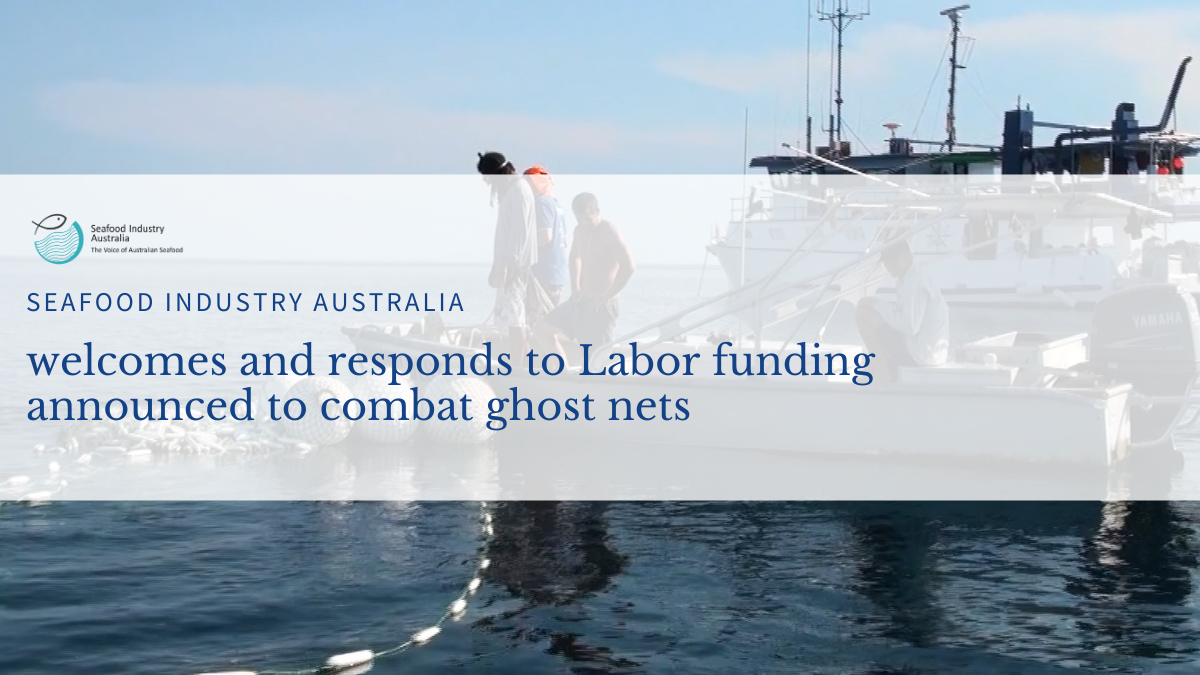
Seafood Industry Australia welcomes and responds to Labor funding announced to combat ghost nets
Seafood Industry Australia (SIA), the national peak-body representing the Australian seafood industry, has welcomed funding announced on Friday, April 21, 2023 by the Labor Government to combat foreign Ghost Nets which have drifted in Australia’s northern waters.
“Australia’s seafood industry has welcomed today’s funding announcement from Tanya Plibersek MP, Minister for the Environment and Water, and affirms our industry’s commitment to caring for Australia’s oceans and environment, and working with government, scientists, marine users, and regulators to encourage they do the same,” SIA CEO Veronica Papacosta said.
“As an industry, we are subject to some of the most intensive fisheries management and reporting protocols in the world. As fishers, our priority is the ocean. It’s our livelihood, and the future livelihood of generations to come
“Australia’s seafood industry is known for our world leading practices and with the support of the Australian Government we look forward to continuing to advance this position. However, omitted from today’s announcement is that 96 per cent of ghost nets found in Australian waters are from international fishers and drift here due to ocean currents.
“The inference that Australia’s commercial fishers are responsible for dumping ghost nets, fishing nets lost at sea, into our oceans is categorically incorrect. In fact, Australia’s commercial fishers work hard to locate and remove ghost nets they find adrift, investing significant time and their own money into this.
“As an industry we welcome any support to help make our Oceans and Environment more sustainable and clean, however it is important we make clear where the problem is originating from.”
WATCH MORE: Caring for our Oceans and Environment – Bruce Davey, ghost net removal
“Ghost nets are not a big problem in Australia, except for the Gulf (of Carpentaria) which is now on the wane due to some intervention by the Indonesian government,” Riki Gunn founder and coordinator of Ghost Nets Australia said earlier.
“We have seen a significant reduction in ghost nets washing up along the west coast of Cape York which we attribute to the Minister of Fisheries in Indonesia taking a hard stance on illegal/unregulated fishing vessels in the Arafura Sea – which were all international fisheries” Heidi Taylor managing director of Taronga Blue and the Australian Marine Debris Initiative said earlier.
“In general I would say that the Australian fisheries do not contribute a significant amount of ghost net debris to Australia’s marine debris load, they are expensive to lose.”
“In fact, Australia’s Northern Prawn Fishery Industry has been commended for working alongside the World Animal Protection to reduce ghost nets in the gulf through the Global Ghost Gear Initiative,” Ms Papacosta said.
“It is misleading to infer these ghosts nets are from our Australian fishers, researchers from James Cook University have estimated more than 85 per cent of the ghost nets found along the Gulf coastline originate from outside of Australia’s Exclusive Economic Zone, most likely from the nearby Arafura Sea between the Gulf and PNG, with the majority from fishers based in Taiwan, Indonesia and Japan.
“Fishing nets are a costly investment and Australian fishers are not in the business of watching their net profits quite literally drift away.
“As fishers our priority is the ocean. We advocate the health, sustainability and future of our ocean, and as such the future of our livelihood.”
<ENDS>
For more information or to organise an interview with SIA CEO Veronica Papacosta please contact SIA Communications and Public Affairs Manager via jessica@463.9af.myftpupload.com

‘Sustainable fisheries targeted in baseless ocean-grab’: Seafood industry responds to Macquarie Island Marine Park announcement
Austral Fisheries (Austral) and Australian Longline Fishing (ALF), along with Seafood Industry Australia (SIA), the national peak body representing Australia’s commercial seafood industry, and the Commonwealth Fisheries Association, the peak-body representing commercial fisheries in Australia’s Commonwealth waters, have condemned the Albanese Government’s announced restructure of the Macquarie Island Marine Park, labelling the tabled plans an ocean-grab funded by international activists with no basis in science, designed to tarnish the sustainably managed Toothfish Fishery.
“Tragically, Minister for the Environment Tanya Plibersek has chosen to use a proposal funded and driven by an international activist group, Pew Charitable Trusts, rather than a proper Australian government review,” Austral CEO David Carter said.
“The redesign of the park represents a serious overreach by the Minister that will send shockwaves through the Australian communities and regions who rely on marine estates for employment, tourism and recreation.”
“This is nothing more than a green-washed PR stunt designed to garner the support of the Greens and teal-independents, while making the eNGOs happy,” SIA CEO Veronica Papacosta said.
“The process of the government using submissions and plans developed by international activists sets a terrifying basis for future land and ocean conservation. If this is a process that will be relied upon by the Albanese Government, then the Australian public and industry requires transparency of this process and how, if at all, it works with existing and endorsed scientific reviews.
“Australia’s primary producers should be extremely concerned by the precedent today’s announcement sets and the ability for a sitting Minister’s agenda to be hijacked by conservation activists.
“The Australian seafood industry welcomes any conversation on sustainability because we are deeply committed to a sustainable ocean. As fishers, our priority is the ocean. It’s our future and the future of generations to come. However, this is an attack on one of the world’s most sustainable, well-managed fisheries. The fact this is happening to two of the world’s most progressive, and forward-thinking fishing companies is a disaster.”
“As part of the proposed Macquarie Island Marine Park restructure, grounds that include the current fishing footprint will be categorised as category four. This means although these areas are technically a marine park zone, they will still permit commercial longline fishing,” CFA Chair Dr George Kailis said.
“Austral and ALF represent the only industry members operating within the Macquarie Island Toothfish Fishery, who will now be forced into taking fish from Marine Parks, despite both operations being classed as sustainable by the Australian Government and independent third-parties. This has poor optics for the businesses and their international trade, and means the clock is ticking for further reduced access in the future.
“This move sends a chilling message to the investment made on environmental and sustainable practices, as demonstrated by both companies.”
“Since 1994, Austral and ALF have supported a collaborative approach to ensuring the entire Macquarie Island ecosystem, including its commercial fishery, is sustainably managed through research, science, industry and conservation inputs, and evidence-based decision making,” ALF Managing Director Malcolm McNeill said.
“Since fishing commenced around Macquarie Island in 1994, and prior to the Macquarie Island Marine Reserve being established in 1999, there have been zero interactions between fishing gear and seabirds, and the measures used for seabird and mammal protection remain a leading global example of collaborative approaches to conservation of marine natural resources,” Mr Carter said.
“In the lead-up to the 2022 Federal Election, the seafood industry received a commitment from the Albanese Government that the statutory review process for the national marine park network, and any refinements, would be considered on the basis of science and stakeholder consultation. This is now a broken promise,” Ms Papacosta said.
“Despite promises to meaningfully engage with industry during the formal review process, the proposed new park boundaries and zone categorisations announced today do not take the views, contributions, or priorities of longstanding fishers into account,” Mr McNeill said.
“During a number of informal meetings, industry views were tabled, and a design developed that was done in good faith to deliver a truly exceptional, world class outcome giving the highest level of protection to 85% of the entire Macquarie Island Exclusive Economic Zone, however, this design appears to have been ignored,” Mr Carter said.
“Macquarie Island is a special part of the world, and the original Marine Park was established in 1999 with full support of industry, science, conservation, and government.”
“Both ALF and Austral have conducted valuable research over almost 30 years, gaining insights, data and IP throughout this time, which was not accessed or utilised during the formal review,” Mr McNeill said.
“The new boundaries will create increased complexity and red tape for operators and the Australian Fisheries Management Authority, the government fisheries regulator, with no change to the conservation outcome. It will also remove sustainable fishing activity from parts of the existing fishing footprint.”
“As an industry that already faces significant scrutiny, this reclassification makes legal fishing operators an easy target for extreme groups, and will ultimately confuse the public, mislead consumers, and adversely impact the commercial viability of this fishery,” Mr McNeill said.
“The message this sends is that the Albanese Government and Minister Plibersek values international activist submissions over collaboration between Australian industry, science, conservation, and government,” Ms Papacosta said.
“This announcement also flags the commencement of the South-east Marine Parks Network Management Plan 2013-2023 review. If we’re going into an environment where actually our concerns, our needs, and our performance aren’t taken into account, we have a real issue.
“For decades, the Australian seafood industry has worked cooperatively with fisheries managers and scientists to implement best-practice protocols to underpin our long-term, sustainable future. This recent process doesn’t add up.
“This decision has missed what could have been an opportunity to proactively engage the Australian seafood community in a discussion on safeguarding the future of our fish-stocks and the environment. Instead it’s nothing more than a greenwashed PR stunt, fueled by personal agenda and a desire to generate publicity.
“Just like the broader community, Australia’s seafood industry cares about the marine environment and we understand the need to protect and ensure the long-term sustainability of fish stocks.
“Together, Australia’s wild-catch fisheries and aquaculture sectors provide fresh, sustainable, high-quality seafood, year-round. Australian seafood is one of the best managed and most sustainable protein sources in the world. Australia has the largest network of Marine Parks in the world with 45% of our waters declared, 48.2% including this announcement. This is well above the AICHI target of 30% by 2030. This protects an area of 744,000 square kilometres and reinforces Australia’s global leadership in ocean protection.
“This move is short-sighted and compromises the entire industry and the long-term future of supply of Australian seafood to consumers, and has broad reaching implications for food security. Moves like this unjustly damage the livelihood, reputation and hard work of tens of thousands of hard-working Australians who work in and rely on our seafood industry. And, they have documented and broad reaching impacts on the mental health of our sector.”
<ENDS>
For interview requests with SIA CEO Veronica Papacosta please contact SIA Communications and Public Affairs Manager Jessica McInerney:
E: jessica@463.9af.myftpupload.com
M: 0420 695 431
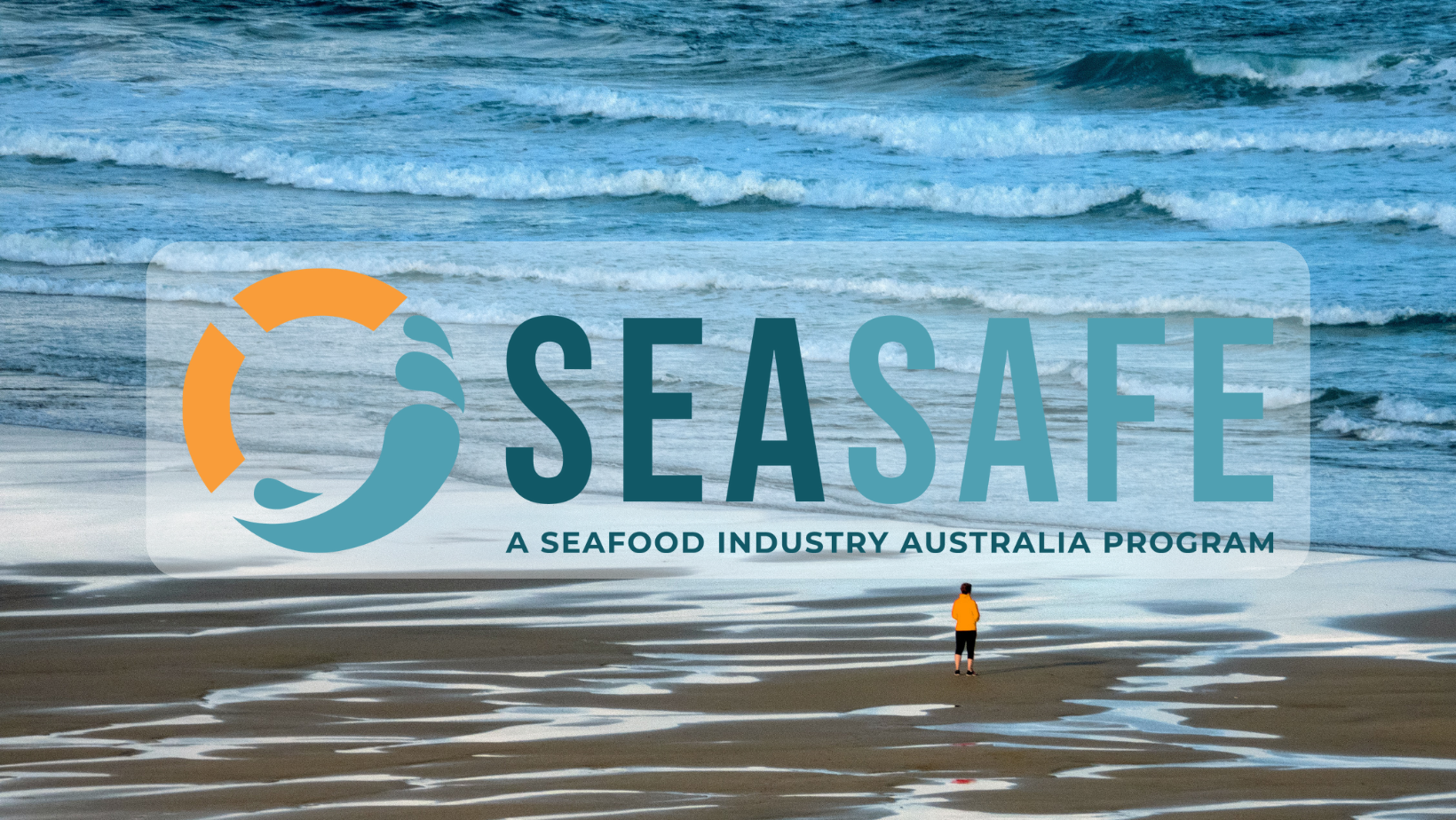
‘Everybody deserves to come home safely’: Commercial seafood industry launches national safety program, Sea Safe
Seafood Industry Australia (SIA), the national peak-body representing Australia’s commercial seafood industry, in conjunction with the Australian Maritime Safety Authority (AMSA) and the Fisheries Research and Development Corporation (FRDC), have launched Sea Safe, a program designed to improve the culture of safety in the commercial seafood industry, at an event held in Fremantle, Western Australia on February 16.
“The safety and wellbeing of our industry and its people is paramount, and we need to do everything we can to ensure our people and our operations are the safest they can be,” SIA CEO Veronica Papacosta said.
“Sea Safe is a four-year program that has been designed to drive culture improvement and change throughout the sector through a focus on peer-to-peer sharing, learning and ultimately behaviour changes.
“Thanks to funding provided by AMSA and FRDC, Sea Safe is a great example of industry and the government working together to address the critical issue of safety.
“Safety is one of SIA, and the entire commercial seafood industries, top priorities and these sorts of initiatives are vital to keeping our seafood producers safe. No matter the industry, everyone deserves to be safe at work and every family deserves their loved-ones to come home unharmed.”
“At AMSA we are committed to ensuring safe vessel operations, including the safety of all crew in Australian waters,” says AMSA Executive Director of Operations, Michael Drake.
“We are pleased to support Sea Safe. This program complements our aim of working in partnership with the maritime industry to improve safety at sea, and we look forward to seeing the benefits to the safety of commercial fishers around Australia.”
FRDC Managing Director Dr Patrick Hone said ensuring the safety of everyone working in commercial fisheries and aquaculture is of critical importance.
“Working at sea and around water is inherently high risk. Most risks can be managed through education and the use of safe practices. FRDC has invested in fishing and aquaculture safety programs and projects throughout Australia, over many years including FRDC-funded programs such as SeSafe and FishSafe that have been instrumental in shaping the new Sea Safe program,” Dr Hone said.
“FRDC is proud to extend our commitment to safety through our investment in Sea Safe. We want all people who work and play in, on or near the water, to be safe and go home to their families, so having a national Sea Safe program will help build a safer culture for all our stakeholders.”
“Sea Safe is a vital initiative aimed at ensuring the safety and sustainability of our nation’s commercial seafood industry. The seafood industry is a significant contributor to the Australian economy and provides employment to thousands of Australians. However, it is also a dangerous profession, with many fishers risking their lives every day to provide for their families and our country,” SIA Wellbeing Program Manager Jo Marshall said.
“Up to 50 seafood communities nationally will be involved in the program, with up to 100 Safety Advocates teaming up to collect and share stories, learning and tools to help keep each other coming home safely from work.
“The program has its foundations in peer-to-peer information sharing and learning. This is a program by industry, for industry. It picks up on the great research already done by FRDC and their stakeholders under the National Seafood Safety Initiative along with the work of SeSafe and Fish Safe, transitioning them into one integrated, national program.
“Throughout the next four years, SIA will continue to develop tools to assist our industry to arrive home safely every time they go to work. The objective of the program is: to achieve a positive change in workplace safety culture to ensure that the Australian Seafood Industry ‘Keeps its People Safe’.”
<ENDS>
The Sea Safe national safety project is led by Seafood Industry Australia, funded by the Australian Maritime Safety Authority and the Fisheries Research and Development Corporation.
For more information or to organise an interview with SIA CEO Veronica Papacosta or Program Manager Jo Marshall please contact SIA communications and public affairs manager Jessica McInerney
E: jessica@463.9af.myftpupload.com M: 0420 695 431
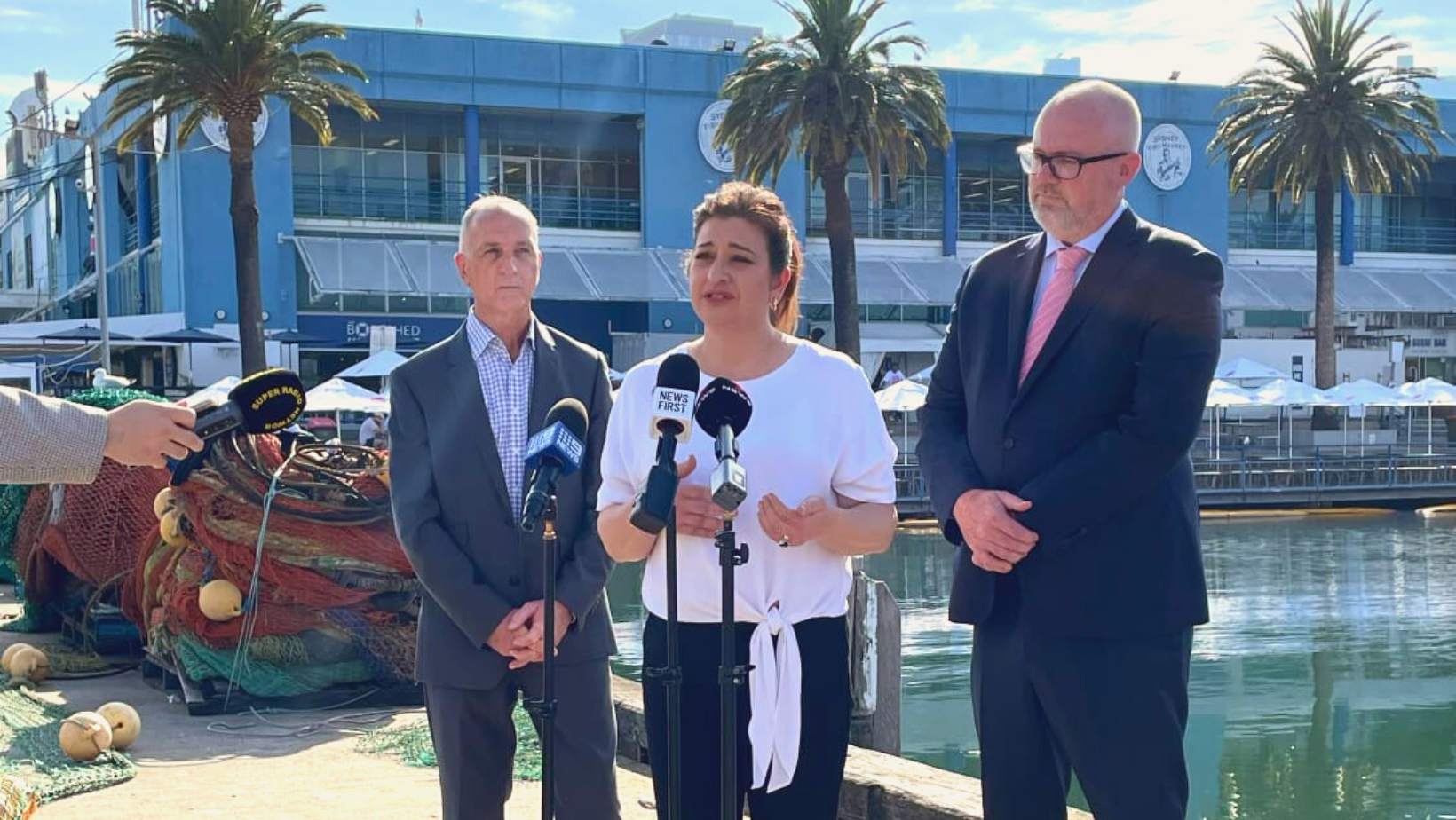
Making it easier to buy Australian seafood
The Australian Government is taking steps to make it easier for Australian consumers to know where seafood products come from.
Today consultation on the proposed Country of Origin Labelling model for seafood in hospitality settings will open.
Many consumers want to know where the food they buy comes from; in one survey, more than three-quarters of participants said they referred to country of origin information when purchasing food in retail settings.
Nationally consistent country of origin labelling is already required for most food sold in retail settings including supermarkets and grocery stories.
But not for hospitality settings like restaurants, cafes and hotels.
Speaking at the Sydney Fish Market today, Assistant Minister for Manufacturing Tim Ayres said the Australian Government is eager to strike the right balance between improving consumer access to information and being practical and low cost for local businesses to make the necessary changes.
“Australians should be able to easily find out where their food comes from. Making seafood labelling clearer, simpler and mandatory will mean people will know if they are purchasing premium local produce,” Assistant Minister Ayres said.
The Government’s proposed model would mean businesses need to indicate if seafood is:
- Australian;
- Imported/international, or
- Mixed origin (containing both Australian and imported seafood).
“These changes won’t be made overnight. We know businesses will need time to adjust to new labelling requirements and we’ll be working closely with businesses to help them through this transition.”
“We’re seeking feedback on the proposal, and I encourage businesses, consumers and the community to provide feedback.
“Australia is home to a world-class seafood industry and consumers deserve to know where their seafood is coming from,” Assistant Minister Ayres said.
Consumers have had access to origin information on most food products sold in retail stores since 2018, when the first set of labelling reforms came into full effect.
A cost-benefit analysis of the scheme found that every $1 of costs incurred generated $3.30 in benefits.
CEO of Seafood Industry Australia Veronica Papacosta welcomed the announcement, noting country of origin is one of the most influential factors for a consumer choosing which seafood to buy.
“The introduction of Country of Origin Labelling in foodservice will allow consumers to make informed decisions about the seafood they buy in restaurants, cafes and take-away food stores across the country, and allow them to support our great Australian seafood producers.
“Right now, for food safety purposes, the supply chain of seafood is known in foodservice all the way to the kitchen door, however, the information is often not passed on.”
A discussion paper and an opportunity to provide views is available at: consult.industry.gov.au until 15 March 2023.
More information on Country of Origin Labelling is available at foodlabels.industry.gov.au.
<ENDS>
AM AYRES MEDIA CONTACT: Katie Booth 0422 343 425
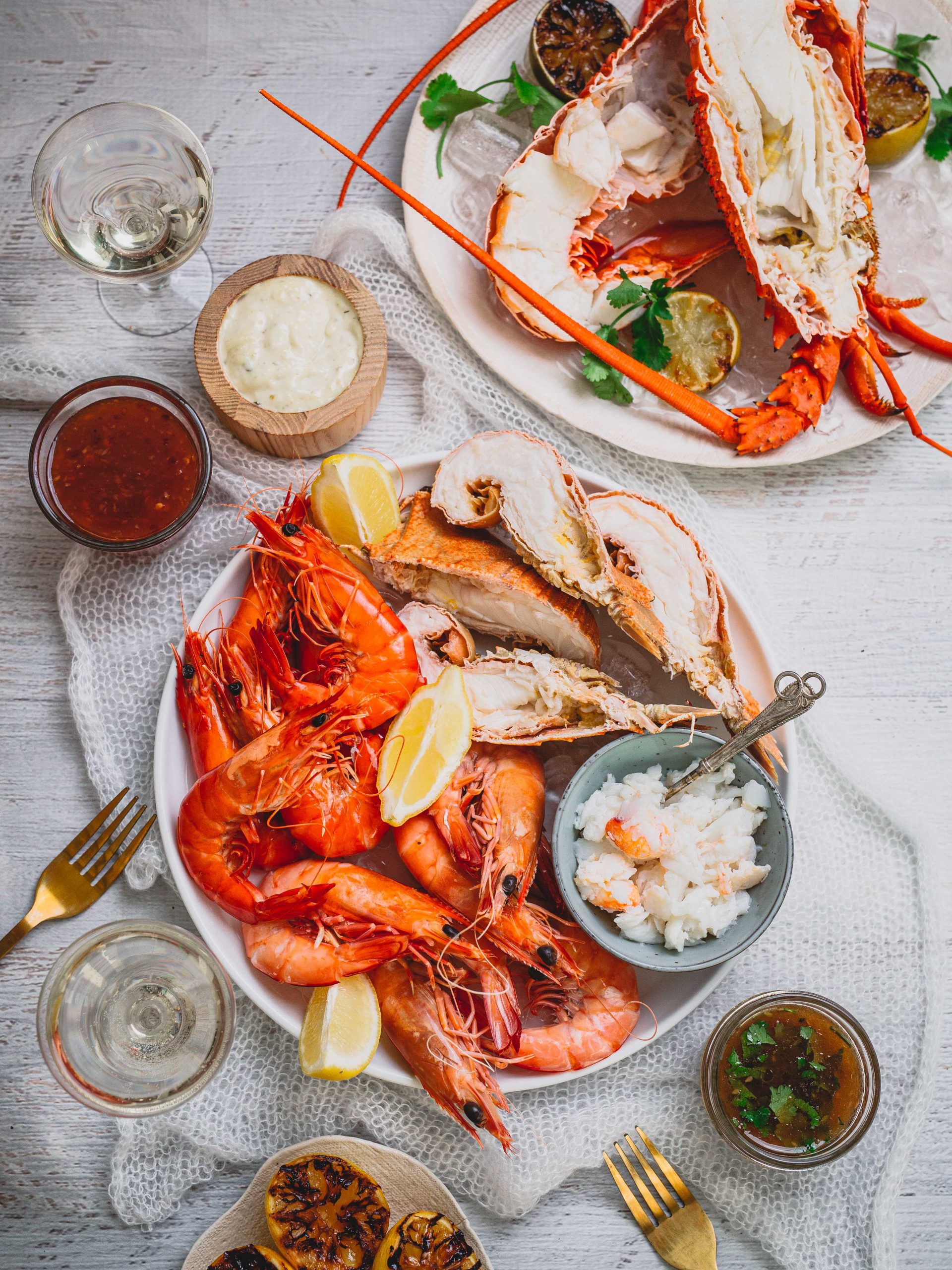
‘Seafood makes a splash as Aussie Christmas icon’: Australian seafood availability for Christmas 2022
It’s O-Fish-aIly Christmas and Seafood Industry Australia (SIA), the national peak body representing the seafood industry, have said the days of the traditional Christmas roast are long gone, having been replaced with a spread of our great Australian seafood. Read on for the insider’s tips on Christmas seafood for 2022.
“Our great Australian seafood has firmly cemented its place as the centrepiece for the quintessential Aussie Christmas lunch,” SIA CEO Veronica Papacosta said.
“Gone are the days of slaving over a hot oven. Nowadays people opt to enjoy some of our delicious, fresh rock oysters with a squeeze of lemon, a few kilos of prawns, a side of smoked salmon, and some of our fantastic rock lobsters.
“Prawns are traditionally the biggest seller of the season, however we are seeing rock lobsters and whole fin-fish like Tasmanian Atlantic Salmon and Barramundi rising in popularity as people opt for seafood over the traditional beef or lamb roast.
“Australian Prawns are abundant this year between our wild-catch and aquaculture operations. We’ve had a fantastic wild-caught King Prawn and Banana Prawn season, they are both looking really good, and our farmed Tiger Prawns are always fantastic.
“If you’re in a coastal community, have a chat with your seafood retailer about your local School Prawns which are often really sweet and can be eaten whole. They are really tasty, deep-fried shell and all, served with a tartare or seafood sauce.
“There is still going to be a really nice abundance of Western Rock Lobsters in the domestic market, consumers can expect to find these in stores for between $30-35 each. People will also find some beautiful Eastern and Southern Rock Lobsters available too. These make a great hero centrepiece as an alternative to a whole ham, or roast. Very impressive.
“Moreton Bay and Balmain Bugs are of lovely quality with really sweet, delicate meat. We expect these to be the same price as last year. Alongside lobster and prawns, bugs can take pride of place on your seafood platter.
“It’s been a tough season for Sydney Rock Oyster growers with the loss of the Port Stephens oyster farms and the ongoing rain events along our Eastern Coast. This will put pressure on the supply available, but the Sydney Rock Oysters in-market are of fantastic quality. Pacific Oysters are looking good; however, they can come into spawn in late December-January so this could impact supply.
“There is some really high-quality, fresh Australian Tuna coming into the market and consumers should be on the lookout for Southern Bluefin Tuna, which has been excellent lately.
“Tasmanian Atlantic Salmon both smoked and fresh should maintain a steady year-round pricing and are always a welcome addition to Christmas and New Year celebrations.
“If you’re looking for a whole fish to roast or BBQ Australian Snappers, Barramundi, Salmon and Ocean Trout are great and readily available. These are all stunning table fish and will make for a show stopping centrepiece. Both whole fish and fillets will be available and there shouldn’t be much of a change in price year-round.
“Our Australian Blue Swimmer and Mud Crabs are always excellent at this time of year, and sit at the higher end of prices.
“Across the entire food supply network there has been impacts to the supply chain and labour shortages, however consumers don’t need to worry, between our aquaculture and wild-caught products there will be a wide variety of Australian seafood available.
“We know Australians love to eat Australian seafood, and if you want to be certain you’re eating sustainable, healthy, world-class seafood this Christmas, always ask for our great Australian seafood .Not sure where to find local seafood? Search fishmongers by postcode using our Fish Finder at www.greataustralianseafood.com.au.
“People should be on the lookout for some of our more underutilised species like Mussels, Calamari or Octopus this Christmas. You might be able to nab yourself a seafood bargain, and maybe even find a new favourite. If you’re not sure how to cook something, take the time to ask your fishmonger for advice.”
<ENDS>
For more information or to organise an interview with SIA CEO Veronica Papacosta please contact
SIA Communications and Public Affairs Manager Jessica McInerney on
e: jessica@463.9af.myftpupload.com or m: 0420 695 431
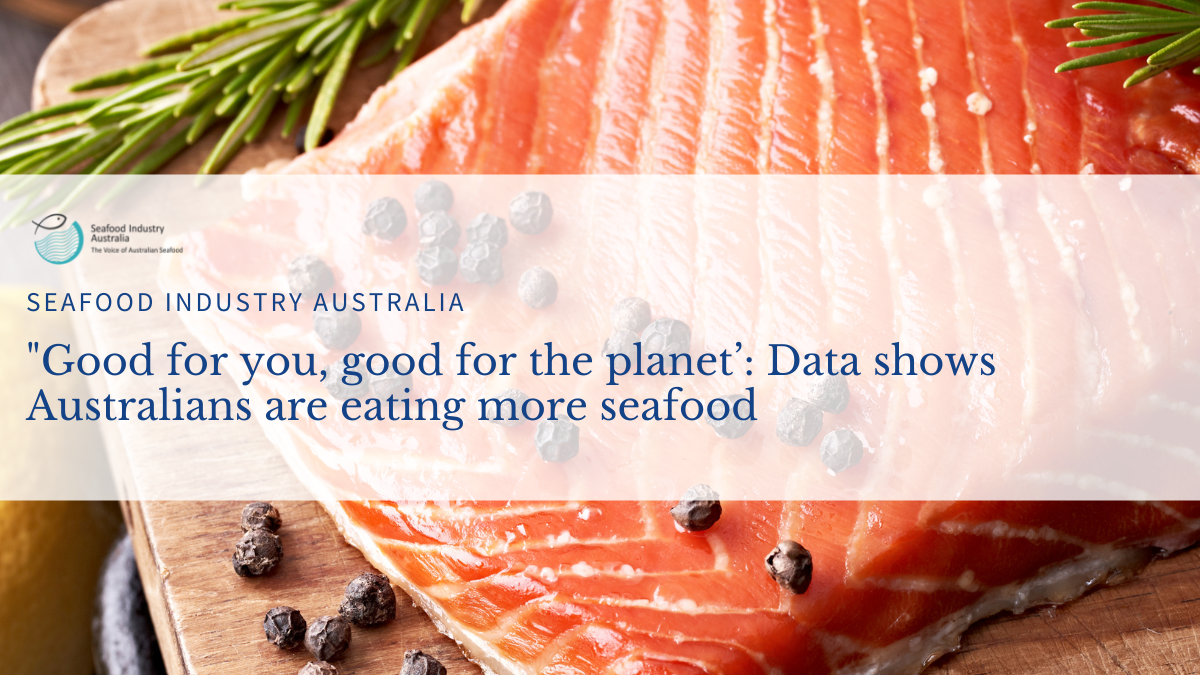
“Good for you, good for the planet’: Data shows Australians are eating more seafood
Seafood Industry Australia (SIA) has welcomed the release of the Australian Fisheries and Aquaculture Statistics 2021, (2022) which has shown an increase in seafood consumption around the country.
It’s no secret the Australian seafood industry has faced a challenging few years, however the release of this report shows the industry is steadily moving forward and that needs to be celebrated.
Australians consumed around 356,000 tonnes of seafood in 2020–21, which is equivalent to 13.9 kilograms per person. This is up 1.5 kilograms per person from 12.4 kilograms per person in 2019-20, and down from a high of 15.5 in 2003-4. This figure includes imported seafood products which accounted for 62 per cent of consumption, down from 66 per cent in previous years.
It’s wonderful to see an increase in seafood consumption, and we thank Australian consumers for their ongoing support of our great, Australian seafood producers. Especially through what has been a difficult few years for industry, and for listening to our requests to “Eat more Aussie seafood”.
Congratulations to Australia’s aquaculture sector maintained steady growth, with the sector’s GVP growing 9% in 2020-21 to $1.73 billion accounting for 56% of the industry’s GVP. This growth can be largely attributed to Tasmania’s growing Atlantic Salmon industry and Queensland’s prawn production.
Over the last two decades we’ve seen Australia’s aquaculture sector grow, which has helped to boost overall fisheries production. In recent years, our aquaculture sector has broadened the composition of species produced, with an increased emphasis on prawns and finfish varieties, like barramundi and kingfish. Australia’s aquaculture sector has a bright future as it continues to set international benchmarks by providing fresh, high-quality, sustainable seafood year-round, while meeting and exceeding regulatory requirements.
In contrast, the GVP of wild-catch species decreased by 12 per cent to $1.4 billion in 2020–21, largely due to lower prices received for rock lobster in export markets. Lower rock lobster production value was driven by trade and pandemic disruptions continuing to limit opportunities in export markets.
Overall, the GVP of Australian fishery and aquaculture in 2020–21 decreased by 1 per cent to $3.09 billion, which was an anticipated results of the trade and pandemic disruptions.
The Australian Fisheries and Aquaculture Statistics 2021 is supported by funding from the Fisheries Research and Development Corporation on behalf of the Australian Government.
<ENDS>
